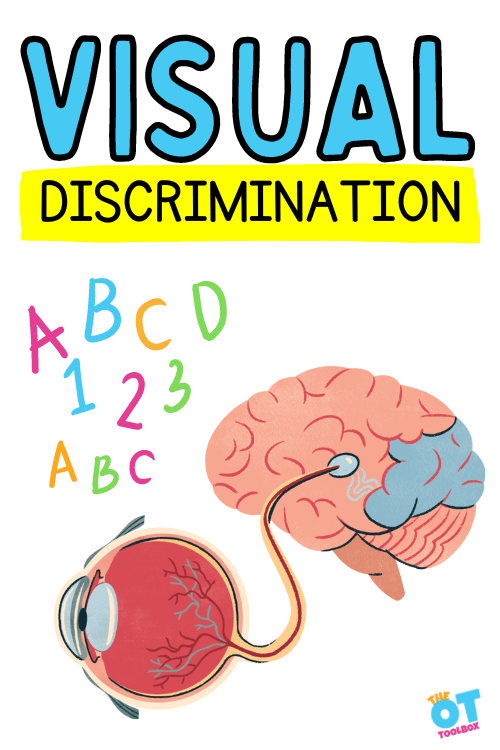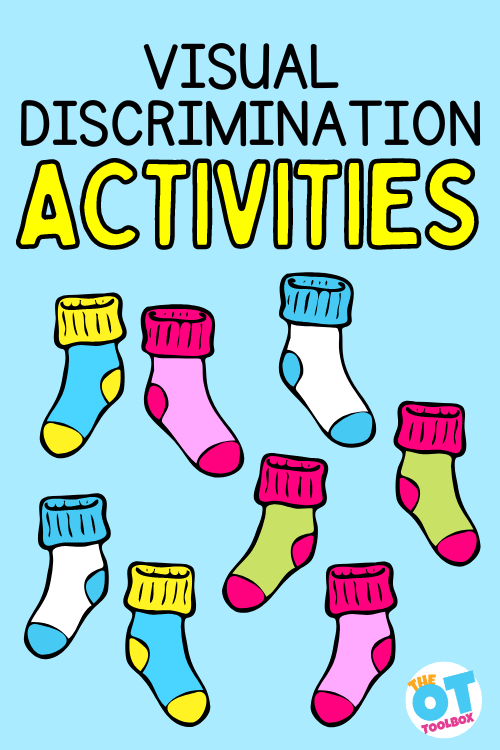Visual discrimination is just one of the seven types of visual perception impacting visual efficiency. While the word “discriminate” has many different meanings, visual discrimination refers to the ability to tell the difference between things. Someone who has “discriminating taste” can tell the difference between Heinz and off brand ketchup, for example.
This blog post is part of a series highlighting Visual Perception.

What is visual discrimination
Visual discrimination can be defined as the ability to is determine and classify objects, symbols, shapes, etc. by differences in color, form, size, texture, or orientation, or shape by the eyes receiving visual input and analyzing that information.
Visual discrimination occurs by the eyes and brain detecting differences in objects, utilizing working memory and stored memory to determine distinct differences or matched features.
This visual skill is necessary for reading, writing, math skills, play, activities of daily living, and essentially all aspects of utilizing visual input.
Visual discrimination is a skill that kids need for so many skills. From identifying and matching socks when getting dressed and doing laundry to recognizing subtle differences in multiple choice problems, visual discrimination is a visual perceptual skill that allows kids to excel in reading, writing, and math activities or struggle!
When explaining visual discrimination, it is important to understand it’s role in visual perception as part of the overall visual processing system. One aspect of visual processing is the component of visual motor skills. Included in visual motor skills are three main areas:
Visual motor skills are made up of several areas:
1. Visual Processing Skills- how the eyes move and collect information. Visual processing skills includes visual tracking, convergence, saccades, visual fixation, and visual attention. A component of visual processing includes visual efficiency.
2. Visual Perceptual Skills- ability to make sense of what we see. Visual perceptual skills are essential for everything from navigating our world to reading, writing, and manipulating items. Visual perception includes visual memory, visual closure, form constancy, visual spatial relations, visual discrimination, visual attention, visual sequential memory, and visual figure ground.
3. Eye-Hand Coordination- Using the visual input effectively and efficiently with the hands allows us to manipulate and manage objects and items. This area enables us to use visual information in a motor action. Eye-hand coordination requires fine motor dexterity, strength, shoulder stability, core stability, etc.
Why is Visual Discrimination Important?
Visual discrimination is critical for reading fluency, writing, and other academic areas. It is also important in everyday activities.
- Finding matching pairs of socks in the drawer. Picking out the navy versus black socks
- Determining when a letter is reversed in handwriting or on paper. Read here about letter reversals and the role visual discrimination plays in reversing letters.
- Picking out the sugar versus the flour when cooking
- Using shampoo before conditioner when they are in similar bottles
- Reading a map to follow the direction of roads
- Selecting the correct items in the grocery store
- Picking out two identical buttons to sew on a shirt from a pile of 30 similar ones
- Scanning a pile of receipts to find the correct one
- Looking for a phone number, while scanning a page or ad
How is Visual Discrimination related to reading or dyslexia?
In order to read fluently, the brain clumps letters together to form familiar words. There are tests that show the beginning two letters to a word with the rest jumbled.
The brain is able to use the context clues to read the jumbled texts. The brain is also able to read upside down, backward, and in different fonts. Perception happens beyond the eyes.
The eyes are just the window, or lens. The brain is responsible for perceiving or making sense of what the lens has seen.
Reading fluently requires quickly being able to tell the difference between fonts, discriminating between similar letters (b, d, p, q), clumping words together, determining where one word begins and ends, recognizing familiar words, and other decoding skills.
People with dyslexia are not readily able to perceive the difference between these similar letters or words. They are able to “see” correctly, but their brain often reverses or mixes the letters and words, making it much more labor intensive to decode. The good news is, the brain can be trained to make sense of what it sees.
Red Flags for Visual Discrimination Difficulties
Once you have determined visual acuity is 20/20, or has been corrected to working vision, watch for these common signs of visual discrimination issues:
- Confusing letters and numbers
- Writing with reversals
- Difficulty correctly reading aloud
- Does not enjoy activities such as reading or puzzles
- Unable to pick out relevant information during open book quizzes, or scanning a page to find an item
- Difficulty finding objects in drawers or cupboards
- Slow or unable to find matching objects with subtle differences
- Delayed or labored acquisition of math and reading skills
- Poor handwriting – difficulty with letter sizing, spacing, line placement, letter formation
- Math difficulties – number reversals, losing place when visually counting, difficulty lining up match figures
Fun Fact!
According to theories, males DO have more difficulty with visual perception than their female counterparts. Males are genetically programmed to hunt, gather, and protect.
They were not hardwired to cook, clean, shop, match items together, etc. Males have not evolved quick enough to meet the ever changing challenges they face on a daily basis!
According to the University of Washington, males can see motion and colors differently than females. This lends to the hunting/protecting theory, however is also linked to autism spectrum disorders in males.
You can give the males in your life some slack when they just “can’t find” the salad dressing in the fridge next time!
Visual Discrimination Tests
When doing visual perceptual testing, it is important to isolate visual perception from motor skills. Having students touch the answers rather than writing them, or calling out letters, is a better measure of visual perception.
The following is a partial list of popular assessments. The VMI subtest is more of a screener than a true visual perception test.
- Motor Free Visual Perception Test
- Test of Visual Perceptual skills
- Developmental Test of Visual Perception
- Visual Motor Integration Perception subtest
- Wide Range Assessment of Visual Motor Abilities
- Jordan Left Right Reversal Test

Visual Discrimination Activities
Visual discrimination activities happen everyday through functional tasks. To work on these specific underlying visual processing skills, it is possible to target visual discrimination development through play, games, and activities.
Additionally, there are numerous worksheets, games, activities, and resources available on visual discrimination.
The good news is, visual perceptual skills can be improved through practice and brain training, and can be incorporated into the client or student’s specific interests and goals.
- Sorting – similar buttons, shades of colors, types of toys, box of 100 crayons by color, similar socks, silverware by type or pattern, coins, laundry, etc.
- Visual discrimination games such as (Amazon affiliate link) Spot it – these games are wildly popular. The OT Toolbox has some Spot It games too
- The OT Toolbox has their own visual perceptual games as well
- Puzzles – teach context clues, sorting pieces, noticing differences
- Word searches
- Printable worksheets such as I Spy, letter discrimination, etc.
- Matching activities like this space matching activity
- Workbooks – (affiliate link) Amazon has some reliable resources
- Toys/games – if toys and games are more your speed, check out this list of visual perception toys
Visual Discrimination Play Ideas
The visual discrimination activities below support development and refinement of the skills needed to process differences in forms or objects.
- Visual Processing Bundle– includes printable visual discrimination activities and information to better understand visual processing skills.
- Free Visual Perception packet– Print these visual discrimination worksheets and use with crayons, pencils, and hands on materials such as wikki sticks or string.
- Sunshine Visual Perception activity- This Google slide deck is a digital therapy activity that supports development of visual discrimination skills.
- Color matching Elmer Activity– Use the children’s book, Elmer, to discriminate between details in a book.
- Finger dexterity exercise– This visual processing activity supports visual discrimination skills by using eye-hand coordination along with utilizing visual information.
- Practice “b” and “d” with sensory writing– Discrimination between letters is an aspect of visual processing that relates to functional performance in reading and learning.
- Color shape discrimination Sort– Sorting shapes by color or form is a preliminary task that can be accomplished by young babies and is a building block for more refined skills.
- Coin discrimination– Visual discrimination skills are needed to sort and use coins when paying for items or counting change.
- Real toy I Spy game– I Spy games are powerful visual discrimination skills. This activity uses real toys and can be replicated at home or in therapy sessions using household objects.
- Letters on the garage door– This gross motor visual discriminaiton task can be played outside or inside.
visual discrimination or visual acuity
The most important testing tool you can use is to rule out “visual acuity” problems before visual perception. Vision plays a major role in learning and visual discrimination is just one aspect of vision and learning.
A pair of glasses is a much easier and straight forward fix than years of visual perceptual training.
Visit a qualified ophthalmologist to check for any vision difficulties. Once these are ruled out, use one of the great testing materials listed above to determine any visual perception deficits.

Victoria Wood, OTR/L is a contributor to The OT Toolbox and has been providing Occupational Therapy treatment in pediatrics for more than 25 years. She has practiced in hospital settings (inpatient, outpatient, NICU, PICU), school systems, and outpatient clinics in several states. She has treated hundreds of children with various sensory processing dysfunction in the areas of behavior, gross/fine motor skills, social skills and self-care. Ms. Wood has also been a featured speaker at seminars, webinars, and school staff development training. She is the author of Seeing your Home and Community with Sensory Eyes.






